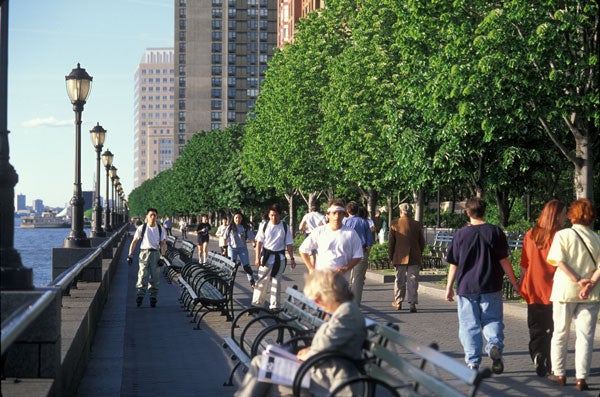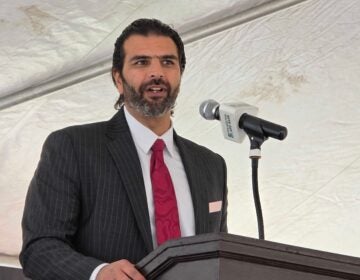Q&A with Alexander Cooper
Nov. 25
By Kellie Patrick Gates
For PlanPhilly
Earlier this week, the Delaware River Waterfront Corporation chose New York firm Cooper, Robertson & Partners to lead the team that will design a plan to guide long-term development along the central Delaware riverfront. This Master Plan, which will focus on the seven-mile stretch between Oregon and Allegheny Avenues, will aim to reunite city neighborhoods with their waterfront and foster a mix of uses, from open space and parkland to residential, commercial, retail, entertainment and industrial buildings.
PlanPhilly had a phone conversation with the winning firm’s principal, Alex Cooper. Cooper’s answers are directly quoted except where parentheses appear. The order of a few question/answer pairs was changed to keep similar subjects together.
Cooper will meet with DRWC to iron out a contract next week, and then will start work on the plan in January. Here’s what he had to say about the project:
PlanPhilly: What made you want to take on this big project?
Alex Cooper: We’ve worked on a lot of waterfronts, and this will probably be the longest one we’ve ever worked on. (The on-going Detroit waterfront project was shorter by one mile.) We’re comfortable working with all of the issues on waterfronts. Battery Park City (in New York) is the first job we ever did. We are still working on the Detroit waterfront. There’s Boston, Memphis – a lot of places. We’re just comfortable with these projects. So this was irresistible – it is Philadelphia, after all.
PP: Why did you find Philadelphia irresistible?
AC: I’ve spent a lot of time here. My brother lived here. I like it a lot.
PP: Was Battery Park the first riverfront job you ever did, or your first job, ever?
AC: It was our first job ever when I opened my office. In 1979. They were crazy to hire us! I opened the firm with three people and they hired us.
PP: We don’t think they think they were crazy to hire you, in retrospect. People seem pleased with what’s happened there.
AC: At Battery Park, we did a lot of things right. What has been most interesting to me is to watch it change over the course of 30 years. And it will continue to change. Now, there are a lot of public facilities in it, like schools. That was never part of the original plan. There are memorials. That was never part of the original plan. That is something one has to keep in mind about large scale plans – they change. Of necessity, and usually for the better.
PP: Is there anything you would do differently if you were doing Battery Park today?
AC: I think probably not. I think the methodology was correct. The setting was so profoundly strong. The first thing we did when we started – there was a previous plan that had all of the office buildings down in the south. We moved them up to the center of the property, and that was exactly the right thing to do. That’s where the transit was. We got the esplanade correct and the street system right. And the architecture is variable. (Not only did Battery Park change over the years, but) they’ve become a different client as well. They are now oriented to the ‘green’ world. All of the recent buildings have reached the highest LEEDS certification, and there’s a focus on sustainability.
PP: Is there anything about the Philadelphia waterfront that makes it different than the ones you’ve worked on before?
AC: There sure is. I used the word the other night (at a public, meet-the-finalists forum) that sums it up the most – the issue is scale. It really is a very long way from one end to the other. Light rail will help that. But the question is, where do you start and what do you start with?
How do you get property control is going to be a key issue up front. But we’ve had other projects we’ve done, where local governments have used condemnation, but only for specific uses. In other places, we have used condemnation for public parks only, not for any private development. That is something that might be considered.
All of the connections back into the neighborhood are right. You do have some important stakeholders on the waterfront, and you are going to get more.
I would say that on most of the waterfronts we’ve worked on recently, residences have been the preferred use. That is certainly the most easy to get underway, although it’s really tough right now for anybody to do. I’m sure the plan will end up with some residential neighborhoods along the way.
A lot of people are very concerned about parking. Those concerns are multi-fold. Some think the garages are too high.
PP: Are you referring to the proposed SugarHouse Casino parking?
AC: Yes. That is something we will look at right away. The casino will be an important stakeholder out there on the water. They should be worked with to expand the interest in the areas around (their development).
PP: When you talked about site control a bit ago, were you referring to the fact that a high percentage of the waterfront property is in private hands?
AC: Yes. Even if you want to put a trail in – something quick like that – to get people used to doing something there, if you’ve got 35 property owners there, it is tedious to try to work out. There has to be some mechanism for property control. We have to get the lawyers starting to think about that.
PP: Do you think site control would be achieved by buying land? Or bartering with the property owners?
AC: I’ve seen every conceivable thing you can think of. In some places, the city has leased the land. Other times, there are land exchanges and swaps – that is happening in New Haven right now.
PP: So, will part of your job be to encourage or convince property owners and developers to do things on the waterfront that fit the plan?
AC: If you show people that the ideas are sensible and that they will work, people will want to do them – and see it is in their best interest. Enlightened self interest is not a bad history of this country.
We did one project where we just upped the zoning so high, that the developers couldn’t help themselves. It was like a salt lick for deer – they came in and bought up all the property and started building.
PP: When you talk about upping the zoning, do you mean increasing the density? And what city was that?
AC: Yes, increased density. And I’m not allowed to tell you (where it was done).
PP: We’ve heard you talk about a whole diversity of uses along the waterfront, but just to be clear, you’re not thinking of making the whole length of it a high-density area, right?
AC: That would never work – for one thing, it would be as big as the whole city of Philadelphia! That won’t happen. There are certain patterns that happen on waterfronts. It happened in Detroit, and it has happened to you guys. Someone comes in and builds one or two high-rise buildings on the water and they fail. They sit there pretty empty. Then a second wave comes, and the housing is more neighborhood scaled than high-rise scaled, and it works. There are exceptions. But most residential stuff that works is 4, 6, 8 stories. That doesn’t mean there aren’t developers who want to do tall ones.
PP: So high density doesn’t have to mean tall buildings?
AC: That’s one of the biggest misconceptions. The densest city in the world is Tokyo, and everything is three stories high. You can make very dense low-rise developments. They are good at that in Texas – in Houston and Dallas.
(Cooper continued to talk about small changes that can make a huge difference in attracting development) We worked in one town where just changing the process of getting development approvals generated a huge interest. I don’t know if that would have an impact here.
PP: We think you’d find a lot of people would be interested in that.
AC: Sometimes it’s even simpler than that. In the early 1970s, I was sitting on the Planning Commission in New York City, and we looked at the zoning for SoHo. SoHo was a rough manufacturing district. We changed one sentence in a 3,000 page zoning book: We would permit artists in residence living in SoHo. Prior, there were no residences permitted. Within a month (a lot of buildings) were converted to residences, artists moved in, galleries moved in.
We’ll look under every rock. We’ll ask developers, why haven’t you moved here? What are the biggest inhibitions? When they tell us why, we will look for tolerable ways of helping out.
PP: If you’re looking at building right along the water in places, won’t there be issues to work out with the U.S. Army Corps of Engineers, the Department of Environmental Protection?
AC: And the Coast Guard, and others – the list goes on and on. It’s something I’m going to find out about very quickly. We always start not just with a land use plan, but we draw a water plan, that looks at all the possible uses that could be on the water. It is interesting to see the land from that perspective. And yes, all the issues you mentioned are there – with the U.S. Army Corps. I haven’t seen where the demarcation line is between the navigable and non-navigable waters yet.
PP: You mentioned the water use plan before, at the meet-the-finalists night. Can you tell us some things that you might be considering for that part of the plan?
AC: It’s too early to know, really. The Philadelphia waterfront has a big history, with industrial, shipping and commerce uses. I don’t know whether it’s possible to think about ferries, marinas, restaurants, right on the water. In Pittsburgh (Cooper has not only done some work in that city, it’s his hometown) they have a flotilla of barges, planted like parks. You have to think creatively about the water, and consider its speed and depth. Generally, recreation uses are popular – and residential. Housing loves water.
PP: Is there any place in particular you’re dying to get started?
AC: That’s a good question. I’ve toured the whole place, from top to bottom. I see all the different issues everywhere. I’m going to be looking for people who are interested in doing things there. I want to talk to the museum people. I want to talk to the hotel people to see if they use the water. I want to talk to the Big Box guys, and to find out why Penn’s Landing has not worked, as many people say it hasn’t. And I want to start seeing the Pier 11 design formulate. I like it – it’s a smaller, digestible piece of the riverfront, but it will have a big impact. Things don’t have to be huge to have a big impact.
PP: Talking about the Big Boxes, like Home Depot and Wal-Mart, in South Philadelphia. A lot of people here refer to those developments and their parking lots derisively. You’ll hear about how Philadelphia is the only city that has a waterfront Wal-Mart. But a lot of people go there. Do you think that area has riverfront potential?
AC: Those places are a huge generator – a huge generator! And a lot of (the people who go) come with kids. An acquaintance of mine happens to have bought the Miami football team. And they sit with a huge parking lot – I mean, vast. Bigger than the Big Boxes’ – that for 350 days a year gets no use. He just came up with the idea to put a splash park there for kids, as a destination, as a way of getting people to come – a giant kids park. That’s a wild idea for a football team! There are no lack of ideas out there.
PP: Is there anything we haven’t asked that we should have asked?
AC: That’s a nice question. Not just with waterfronts – although it is clearly true of waterfronts – every time we have done one of these that is successful, there is a truly committed client behind it. That is the clue to making these things happen. The (Delaware River Waterfront) Corporation is going to have to become really steely and smart. I said the other night that the plan has to be simple so that it will survive different governments and mayors and all the rest – I really meant that. The plan language needs to be such that people can really understand and relate to it. Constancy is a real serious asset on the waterfront. That’s what I hope this client grows into, and we with them.
Contact the reporter at kelliespatrick@gmail.com
WHYY is your source for fact-based, in-depth journalism and information. As a nonprofit organization, we rely on financial support from readers like you. Please give today.








